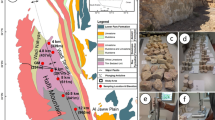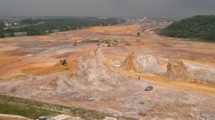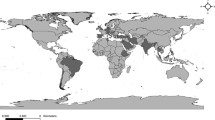Abstract
Measuring unconfined compressive strength (UCS) using standard laboratory tests is a difficult, expensive, and time-consuming task, especially with highly fractured, highly porous, weak rock. This study aims to establish predictive models for the UCS of carbonate rocks formed in various facies and exposed in Tasonu Quarry, northeast Turkey. The objective is to effectively select the explanatory variables from among a subset of the dataset containing total porosity, effective porosity, slake durability index, and P-wave velocity in dry samples and in the solid part of samples. This was based on the adjusted determination coefficient and root-mean-square error values of different linear regression analysis combinations using all possible regression methods. A prediction model for UCS was prepared using generalized regression neural networks (GRNNs). GRNNs were preferred over feed-forward back-propagation algorithm-based neural networks because there is no problem of local minimums in GRNNs. In this study, as a result of all possible regression analyses, alternative combinations involving one, two, and three inputs were used. Through comparison of GRNN performance with that of feed-forward back-propagation algorithm-based neural networks, it is demonstrated that GRNN is a good potential candidate for prediction of the unconfined compressive strength of carbonate rocks. From an examination of other applications of UCS prediction models, it is apparent that the GRNN technique has not been used thus far in this field. This study provides a clear and practical summary of the possible impact of alternative neural network types in UCS prediction.















Similar content being viewed by others
Abbreviations
- ϕ :
-
Porosity
- AdjR 2 :
-
Adjusted determination coefficient
- k :
-
Number of parameters in the model
- I d (%):
-
Slake durability index (fourth cycle)
- MSE i :
-
Mean of residual squares in the model with i parameters
- n (%):
-
Total porosity
- N :
-
Number of data
- n e (%):
-
Effective porosity
- R 2 :
-
Determination coefficient
- S :
-
Smoothing parameter
- S d :
-
Output from the denominator neuron
- S j :
-
Output from the jth numerator neuron
- u i :
-
Input portion of the ith training vector represented by the ith neuron in the pattern layer
- V :
-
Volume of the sample
- V fl :
-
Velocity in the fluid
- V m :
-
P-wave velocity in rock samples lacking pores and fissures
- V p :
-
P-wave velocity in the sample
- W d :
-
Weight of the sample in the dried condition
- W ij :
-
Weight vector between the pattern layer and summation layer
- W s :
-
Weight of the sample in the saturated condition
- X :
-
Input vector
- y j :
-
Output vector
- θ i :
-
Output from the ith neuron in the pattern layer
- ρ d :
-
Density of solid particles
- ρ s :
-
Dry density
- ρ w :
-
Water density
- σ 2 :
-
Variance of the dependent variable
References
Altindag R, Alyildiz IS, Onargan T (2004) Technical note: mechanical property degradation of ignimbrite subjected to recurrent freeze–thaw cycles. Int J Rock Mech Min Sci 41:1023–1028
Alvarez Grima M, Babuska R (1999) Fuzzy model for the prediction of unconfined compressive strength of rock samples. Int J Rock Mech Min Sci 36:339–349
Barton N (2007) Fracture-induced seismic anisotropy when sharing is induced in production from fractured reservoirs. J Seism Explor 16:115–143
Baykasoğlu A, Güllü H, Çanakçı H, Özbakır L (2008) Predicting of compressive and tensile strength of limestone via genetic programming. Expert Syst Appl 35:111–123
Bell FG (1978) The physical and mechanical properties of Fell sandstones. North-umberland, England. Eng Geol 12:1–29
Brook N (1985) The equivalent core diameter method of size and shape correction in point load test. Int J Rock Mech Min Sci Geomech 22:61–70 (Abstr.)
Canakci H, Pala M (2007) Tensile strength of basalt from a neural network. Eng Geol 94:10–18
Ceryan S, Tudes S, Ceryan N (2008) A new quantitative weathering classification for igneous rocks. Environ Geol 55:1319–1336
Cevik A, Sezer EA, Cabalar AF, Gokceoglu C (2011) Modeling of the unconfined compressive strength of some clay-bearing rocks using neural network. Appl Soft Comput 11:2587–2594
Chang C, Zoback MD, Khaksar A (2006) Empirical relations between rock strength and physical properties in sedimentary rocks. J Petrol Sci Eng 51:223–237
Cigizoglu HK (2005) Generalized regression neural networks in monthly flow forecasting. Civil Eng Environ Syst 22(2):71–84
Cobanoğlu İ, Çelik SB (2008) Estimation of uniaxial compressive strength from point load strength, Schmidt hardness and P-wave velocity. Bull Eng Environ 67:491–498
Doberenier L, De Freitas MH (1986) Geotechnical properties of weak sandstones. Geotech 36:79–94
Fahy MP, Guccione MJ (1979) Estimating strength of sandstone using petrographic thin-section data. Bull Assoc Eng Geol 16:467–485
Franklin JA, Chandra A (1972) The slake durability test. Int J Rock Mech Min Sci 9(1):325–341
Gokceoglu C (2002) A fuzzy triangular chart to predict the unconfined compressive strength of the Ankara agglomerates from their petrographic composition. Eng Geol 66:39–51
Gokceoglu C, Zorlu K (2004) A fuzzy model to predict the unconfined compressive strength and modulus of elasticity of a problematic rock. Eng Appl Artif Intell 17:61–72
Gokceoglu C, Zorlu K, Ceryan S, Nefeslioglu HA (2009) A comparative study on indirect determination of degree of weathering of granites from some physical and strength parameters by two soft computing techniques. Mater Charact 60:1317–1327
Gundogdu N (1982) The geological, geomechanical and mineralogical investigation of Bigadic Sedimantery Basin aged Neogen. PhD thesis, HÜ Engineering Faculty, Beytepe, Ankara, p 368s
Hack H, Huisman M (2002) Estimating the intact rock strength of a rock mass by simple means. In: van Rooy JL, Jermy CA (eds) Proceedings of 9th congress of the international association for engineering geology and the environment, Durban, South Africa
Hawkins A, McConnell BJ (1990) Influence of geology on geomechanical properties of sandstones. In: 7th international congress on rock mechanics. Balkema, Rotterdam, pp 257–260
ISRM (1981) In: Brown ET (ed) Rock characterization, testing and monitoring-ISRM suggested methods. Pergamon, Oxford, p 211
ISRM (2007) The complete ISRM suggested methods for rock characterization, testing and monitoring: 1974–2006. In: Ulusay R, Hudson JA (eds) Suggested methods prepared by the commission on testing methods, International society for rock mechanics. ISRM Turkish National Group, Ankara, p 628
Ji T, Lin T, Lin X (2006) A concrete mix proportion design algorithm based on artificial neural networks. Cem Concr Res 36:1399–1408
Kahraman S (2001) Evaluation of simple methods for assessing the unconfined compressive strength of rock. Int J Rock Mech Min Sci 38:981
Kahraman S, Alber M (2006) Estimating the unconfined compressive strength and elastic modulus of a fault breccia mixture of weak rocks and strong matrix. Int J Rock Mech Min Sci 43:1277–1287
Kahraman S, Gunaydin O, Alber M, Fener M (2009) Evaluating the strength and deformability properties of misis fault breccia using artificial neural networks. Expert Syst Appl 36:6874–6878
Kahraman S, Alber M, Fener M, Gunaydin O (2010) The usability of Cerchar abrasivity index for the prediction of UCS and E of Misis Fault Breccia: regression and artificial neural networks analysis. Expert Syst Appl 37:8750–8756
Kayabali K, Selçuk L (2010) Nail penetration test for determining the uniaxial compressive strength of rock. Int J Rock Mech Min Sci 47(2):265–271
McQuarrie AD, Tsai C (1998) Regression and time series model selection. World Scientific Publishing Co. Pte. Ltd., River Edge
Meulenkamp F (1997) Improving the prediction of the UCS, by Equotip readings using statistical and neural network models. In: Memoirs of the Centre for Engineering Geology in the Netherlands, vol 162, p 127
Meulenkamp F, Alvarez Grima M (1999) Application of neural networks for the prediction of the unconfined compressive strength (UCS) from Equotip hardness. Int J Rock Mech Min Sci 36:29–39
Moller MF (1993) A scaled conjugate gradient algorithm for fast supervised learning. Neural Netw 6:523–533
Neter J, Kutner M, Nachtsheim C, Wasserman W (1996) Applied linear statistical models. McGraw-Hill, NY
Okkan U, Dalkilic HY (2011) Reservoir inflows modeling with artificial neural networks: the case of Kemer Dam in Turkey. Fresenius Environ Bull 20(11):3110–3119
Oyler DC, Mark C, Melinda GM (2010) In situ estimation of roof rock strength using sonic logging. Int J Coal Geol 83:484–490
Romana M (1999) Correlation between unconfined compressive and point-load (Franklin tests) strengths for different rock classes. In: 9th ISRM congress vol 1, Balkema, pp 673–676
Sarkar K, Tiwary A, Singh TN (2010) Estimation of strength parameters of rock using artificial neural networks. Bull Eng Environ 69:599–606
Serbes ZA, Okkan U (2011) Modeling of streamflows by using generalized regression neural networks (in Turkish). 5.Ulusal Su Mühendisliği Sempozyumu Bildiriler Kitabı (Cilt II), pp 537–546
Shakoor A, Bonelli RE (1991) Relationship between petrographic characteristics, engineering index properties and mechanical properties of selected sandstones. Bull Assoc Eng Geol 28:55–71
Sharma S (1996) Applied multivariate techniques. Wiley, Canada
Singh TN, Dubey RK (2000) A study of transmission velocity of primary wave (P-Wave) in coal measures sandstone. J Sci Ind Res India 59:482–486
Singh A, Harrison A (1985) Standardized principal components. Int J Remote Sens 6:883–896
Singh VK, Singh D, Singh TN (2001) Prediction of strength properties of some schistose rocks from petrographic properties using artificial neural networks. Int J Rock Mech Min Sci 38:269–284
Sonmez H, Tuncay E, Gokceoglu C (2004) Models to predict the unconfined compressive strength and the modulus of elasticity for Ankara Agglomerate. Int J Rock Mech Min Sci 41:717–729
Specht DF (1991) A general regression neural network. IEEE Trans Neural Netw 2(6):568–576
Temel A, ve Gundogdu MN (1996) Zeolite occurrences and the erionite—mesothelioma relationship in Cappadocia. Mineralium Deposita, Central Anatolia, vol 31, pp 539–547
Ulusay R, Tureli K, Ider MH (1994) Prediction of engineering properties of a selected litharenite sandstone from its petrographic characteristics using correlation and multivariate statistical techniques. Eng Geol 37:135–157
Ulusay R, Gokceoglu C, Sulukcu S (2001) Draft ISRM suggested method for determining block punch index (BPI). Int J Rock Mech Min Sci 38:1113–1119
Yagiz S, Sezer EA, Gokceoglu C (2011) Artificial neural Networks and nonlinear regression techniques to assess the influence of slake durability cycles on the prediction of uniaxial compressive strength and modulus of elasticity for carbonate rocks. Int J Numer Anal Methods Geomech. doi:10.002/nag.1066, online
Yilmaz I (2010) Use of the Core Strangle Test for tensile strength estimation and rock mass classification. Int J Rock Mech Min Sci 47(5):845–850
Yilmaz I, Yuksek AG (2008) An example of artificial neural network (ANN) application for indirect estimation of rock parameters. Rock Mech Rock Eng 41(5):781–795
Yilmaz I, Yuksek AG (2009) Prediction of the strength and elasticity modulus of gypsum using multiple regression, ANN and ANFIS models. Int J Rock Mech Min Sci 46(4):803–810
Yilmaz I, Marschalko M, Bednarik M, Kaynar O, Fojtova L (2011) Neural computing models for prediction of permeability coefficient of coarse-grained soils. Neural Comput Applic. doi:10.1007/soo521-011-0535-4
Zorlu K, Gokceoglu C, Ocakoglu F, Nefeslioglu HA, Acikalin S (2008) Prediction of unconfined compressive strength of sandstones using petrography-based models. Eng Geol 96:141–158
Author information
Authors and Affiliations
Corresponding author
Rights and permissions
About this article
Cite this article
Ceryan, N., Okkan, U. & Kesimal, A. Application of Generalized Regression Neural Networks in Predicting the Unconfined Compressive Strength of Carbonate Rocks. Rock Mech Rock Eng 45, 1055–1072 (2012). https://doi.org/10.1007/s00603-012-0239-9
Received:
Accepted:
Published:
Issue Date:
DOI: https://doi.org/10.1007/s00603-012-0239-9




